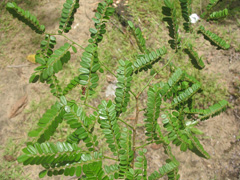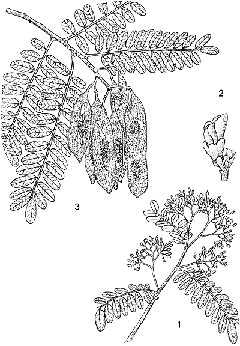 |
|
https://edibleplants.org/ |
 |
| https://edibleplants.org/ |
Translate this page:
Summary
Endemic to Madagascar, Dalbergia monticola is a deciduous tree typically about 15 m in height with a short bole of up to 100 cm in diameter. It has a symbiotic relationship with certain soil bacteria that forms root nodules and fix atmospheric nitrogen. The wood is moderately heavy to heavy and ideal for making musical instruments, precision equipment, cabinets and furniture, carvings, and veneer and plywood among others.
Physical Characteristics

 Dalbergia monticola is a deciduous Tree growing to 12 m (39ft) by 12 m (39ft) at a slow rate.
Dalbergia monticola is a deciduous Tree growing to 12 m (39ft) by 12 m (39ft) at a slow rate.
See above for USDA hardiness. It is hardy to UK zone 10. The flowers are pollinated by Insects.
It can fix Nitrogen.
Suitable for: light (sandy), medium (loamy) and heavy (clay) soils and prefers well-drained soil. Suitable pH: mildly acid, neutral and basic (mildly alkaline) soils. It cannot grow in the shade. It prefers moist soil.
UK Hardiness Map
US Hardiness Map
Synonyms
Plant Habitats
Edible Uses
References More on Edible Uses
Medicinal Uses
Plants For A Future can not take any responsibility for any adverse effects from the use of plants. Always seek advice from a professional before using a plant medicinally.
None known
References More on Medicinal Uses
The Bookshop: Edible Plant Books
Our Latest books on Perennial Plants For Food Forests and Permaculture Gardens in paperback or digital formats.

Edible Tropical Plants
Food Forest Plants for Hotter Conditions: 250+ Plants For Tropical Food Forests & Permaculture Gardens.
More

Edible Temperate Plants
Plants for Your Food Forest: 500 Plants for Temperate Food Forests & Permaculture Gardens.
More

More Books
PFAF have eight books available in paperback and digital formats. Browse the shop for more information.
Shop Now
Other Uses
Furniture Wood
Other Uses: The heartwood is greyish yellow-brown to reddish brown or dark brown, often with darker stripes; it is distinctly demarcated from the sapwood. The grain is generally straight, texture fine and even; when fresh the wood has a sweetish smell. The wood is moderately heavy to heavy; it is moderately durable and resistant to termites. It air-dries satisfactorily but slowly; turned pieces used for precision equipment or musical instruments should be dried thoroughly to avoid distortion. Once dry, the wood is very stable in service. The wood works well, both with hand tools and machine tools; it finishes well, taking a beautiful polish; the nailing properties are moderate and pre-boring is needed; finishing with oil-based paint gives moderate results; the gluing properties are variable. The wood is much in demand for cabinet making, furniture, marquetry and parquet flooring. It is one of the favoured woods for musical instruments, especially guitars, not only because of its beautiful colour and venation, but also because of its clearness of tone. It is also suitable for interior trim, joinery, ship and boat building, vehicle bodies, precision equipment, carvings, toys and novelties, turnery, pattern making, veneer and plywood[ 299 ].
Special Uses
Nitrogen Fixer
References More on Other Uses
Cultivation details
A plant of the moister tropics, where it can be found at elevations up to 1,600 metres. It is found in regions where the mean annual temperature is in the range 18 - 23°c, and the mean annual rainfall is 750 - 2,500 mm[ 299 ]. Trees are probably slow-growing[ 299 ]. A long lived plant, surviving for more than 200 years[ 299 ]. Seedlings are rarely found more than 10 - 20 metres from the trunk of the parent tree[ 299 ]. This species has a symbiotic relationship with certain soil bacteria, these bacteria form nodules on the roots and fix atmospheric nitrogen. Some of this nitrogen is utilized by the growing plant but some can also be used by other plants growing nearby[ 299 ].
References Carbon Farming Information and Carbon Sequestration Information
Temperature Converter
Type a value in the Celsius field to convert the value to Fahrenheit:
Fahrenheit:
The PFAF Bookshop
Plants For A Future have a number of books available in paperback and digital form. Book titles include Edible Plants, Edible Perennials, Edible Trees,Edible Shrubs, Woodland Gardening, and Temperate Food Forest Plants. Our new book is Food Forest Plants For Hotter Conditions (Tropical and Sub-Tropical).
Shop Now
Plant Propagation
Like many species within the family Fabaceae, once they have been dried for storage the seeds of this species may benefit from scarification before sowing in order to speed up germination. This can usually be done by pouring a small amount of nearly boiling water on the seeds (being careful not to cook them!) and then soaking them for 12 - 24 hours in warm water. By this time they should have imbibed moisture and swollen - if they have not, then carefully make a nick in the seedcoat (being careful not to damage the embryo) and soak for a further 12 hours before sowing[ K ]. Air layering has been successful on an experimental basis[ 299 ].
Other Names
If available other names are mentioned here
Hazovola - Malagasy, tsiandalana - Malagasy, voamboana - Malagasy.
Native Range
AFRICA: Madagascar (e.-c. & n.)
Weed Potential
Right plant wrong place. We are currently updating this section.
Please note that a plant may be invasive in one area but may not in your area so it's worth checking.
Conservation Status
IUCN Red List of Threatened Plants Status : Status: Vulnerable A1cd+2cd

| Related Plants
|
| Latin Name | Common Name | Habit | Height | Hardiness | Growth | Soil | Shade | Moisture | Edible | Medicinal | Other |
| Dalbergia baronii | Palissandre rouge des marais, hitsika, sovodrano | Tree | 20.0 |
10-12
| M | LM | N | Mwe | 0 | 0 | 4 |
| Dalbergia cochinchinensis | Siam Rosewood, Thailand Rosewood | Tree | 25.0 |
10-12
| S | LMH | N | M | 0 | 0 | 4 |
| Dalbergia greveana | Madagascar Rosewood | Tree | 15.0 |
10-12
| S | LMH | N | DM | 0 | 2 | 4 |
| Dalbergia hupeana | | Tree | 15.0 |
-
| | LMH | SN | M | 1 | 1 | 3 |
| Dalbergia latifolia | Black Rosewood, East Indian Rosewood, Kala sheeshan, Satisal | Tree | 30.0 |
10-12
| M | LMH | N | M | 0 | 2 | 4 |
| Dalbergia louvelii | Andramena, Volombodipona, Violet rosewood | Tree | 15.0 |
10-12
| M | LMH | N | M | 0 | 2 | 4 |
| Dalbergia melanoxylon | African Blackwood, Grenadilla, Mpingo | Tree | 6.0 |
10-12
| S | LMH | N | DM | 0 | 2 | 5 |
| Dalbergia nigra | Brazilian Rosewood | Tree | 20.0 |
10-12
| M | LMH | N | DM | 0 | 0 | 4 |
| Dalbergia oliveri | Redwood | Tree | 23.0 |
10-12
| S | LMH | SN | M | 0 | 0 | 4 |
| Dalbergia retusa | Cocobolo | Tree | 20.0 |
10-12
| S | LMH | N | M | 0 | 0 | 4 |
| Dalbergia stevensonii | Honduras Rosewood | Tree | 20.0 |
10-12
| S | LMH | N | M | 0 | 0 | 4 |
|
Growth: S = slow M = medium F = fast. Soil: L = light (sandy) M = medium H = heavy (clay). pH: A = acid N = neutral B = basic (alkaline). Shade: F = full shade S = semi-shade N = no shade. Moisture: D = dry M = Moist We = wet Wa = water.
Now available:
Food Forest Plants for Mediterranean Conditions
350+ Perennial Plants For Mediterranean and Drier Food Forests and Permaculture Gardens.
[Paperback and eBook]
This is the third in Plants For A Future's series of plant guides for food forests tailored to
specific climate zones. Following volumes on temperate and tropical ecosystems, this book focuses
on species suited to Mediterranean conditions—regions with hot, dry summers and cool, wet winters,
often facing the added challenge of climate change.
Read More
Expert comment
Author
Bosser & R.Rabev.
Botanical References
Links / References
For a list of references used on this page please go here
A special thanks to Ken Fern for some of the information used on this page.
Readers comment
| Add a comment |
|
If you have important information about this plant that may help other users please add a comment or link below. Only comments or links that are felt to be directly relevant to a plant will be included. If you think a comment/link or information contained on this page is inaccurate or misleading we would welcome your feedback at [email protected]. If you have questions about a plant please use the Forum on this website as we do not have the resources to answer questions ourselves.
* Please note: the comments by website users are not necessarily those held by PFAF and may give misleading or inaccurate information.
To leave a comment please Register or login here All comments need to be approved so will not appear immediately.
|
Subject : Dalbergia monticola
|
|
|
|